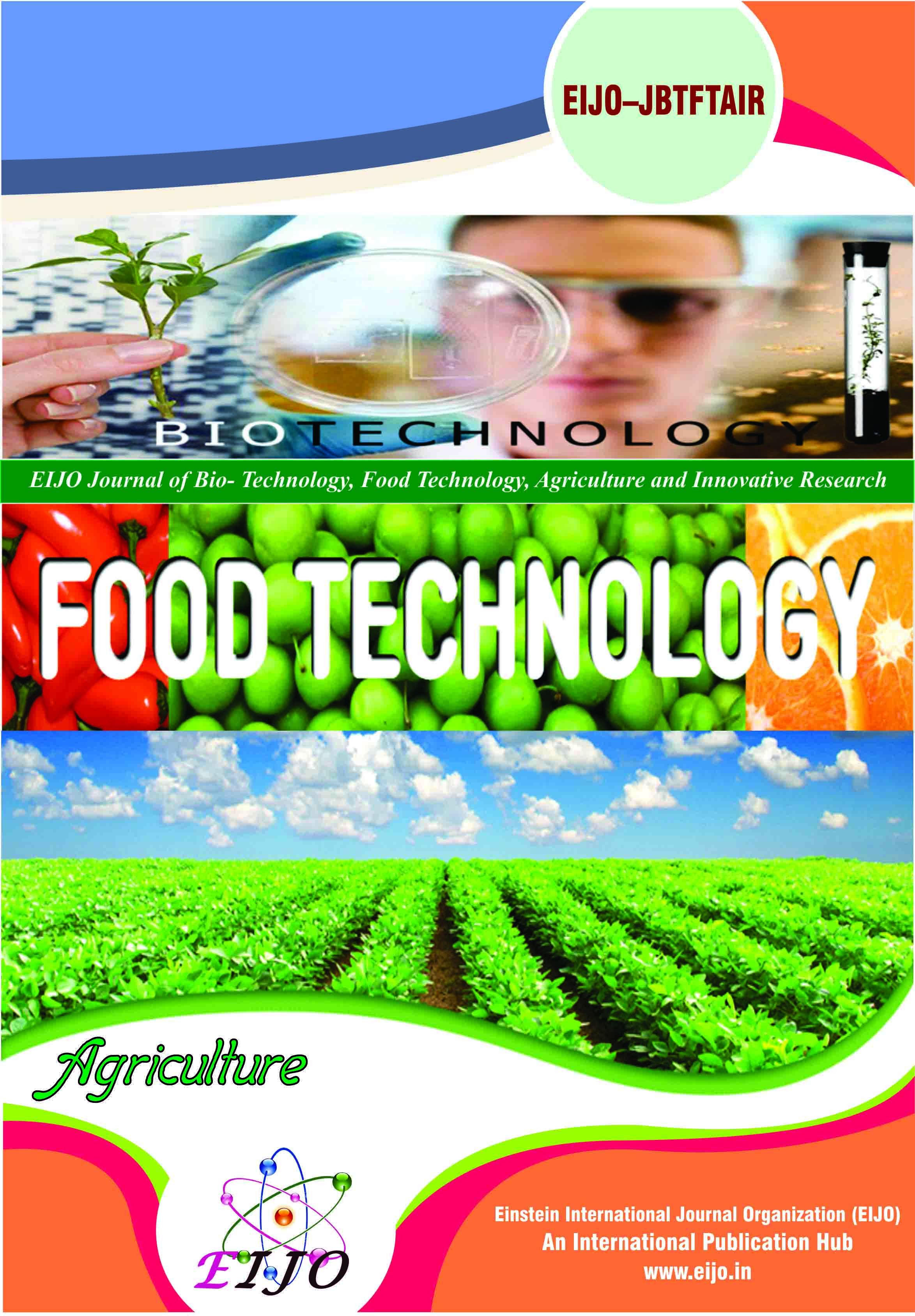JOURNALS || EIJO Journal of Bio- Technology, Food Technology, Agriculture and Innovative Research (EIJO – JBTFTAIR) [ISSN : 2455 - 992X ]
Abstract
Sorghum is considered as one of the most important crops in Sudan economically and nutritionally. The objective of this research was to study the effects of X-ray, Gamma-ray and UV light on some morphological and yield components of the second generation of sorghum (Sorghum bicolor (L.) Moench). The first generation samples of sorghum seeds were brought from the Center of Biosciences and Biotechnology, University of Gezira. Some of the first generation sorghum seed samples were irradiated by two dose of X-rays (33.4 and 200.2 sec.), and two doses of gamma rays (200 CGY and 800 CGY), while the dose of ultra violet (UV) that used for general sterilization purposes against microorganisms was also used. The samples were planted in The Experimental Farm, University of Gezira. Vegetative growth parameters included, (plant weight, plant shoot length, number of fibrous roots/plant, number of leaves/plant, length of larger leaves, number of tillers/plant) and yield parameters included, (number. of heads/plant number of seeds/head and mean weight of seeds). The data were subjected to the appropriate statistical analysis. The results of this study revealed that, all treatments showed varying effects on all vegetative growth and yield parameters. There were some correlations (e.g. between number of roots and weight, number of roots and number of tillers, and also between plant weight and plant length). The F2 did not showed similarity to the F1 in most of the tested parameters. All irradiated groups, did not showed hypothetical high yield components (the production in the control (1643.02 kg\ha), LX (3299.45 kg\ha), HX (1086.54 kg\ha), LG (1108.76 kg\ha), HG (1917.54 kg\ha) and UV (1385.14 kg\ha). The research recommended further studies concerning the flour quality and resistance to diseases and pests in the irradiated sorghum.
References
|
Ahmed, M. A. E. (2011). The effects of X- rays on some physical and chemical characteristics of first generation Sesame (Sesamum indicum L.) and Sunflower (Helianthus annus L.) seeds. M.Sc. Thesis, University of Gezira. |
|
Ahmed, T. A. M. (2013). The effects of X- ray, Gamma ray and UV light on some morphological characteristics and Yield component of the first generation of sorghum (Sorghum bicolor (L.) Moench). M.Sc. Thesis, University of Gezira. |
|
Almodares, A. and Hadi, M. R. (2010). Production of bioethanol from sweet sorghum: A review. African J. of Agricultural Recearch, 4 (9): 772-780. |
|
Aminetzach, Y. T.; Macpherson, J. M. and Petrov, D. A. (2005). Pesticide resistance via transposition–mediated adaptive gene truncation in Drosophila. Science, 309 (5735): 764-767. |
|
Asiedu, A.; Lied, E.; Nilsen, R. and Sandnes, K. (1993). Effect of processing (sprouting and/or fermentation) on sorghum and maize: II. Vitamins and amino acid composition. Biological utilization of maize protein. Food Chem., 48:201-204. |
|
Berrington, A.; de Gonzalez, A. and Darby, S. (2004). Risk of cancer from diagnostic X-rays: estimates for the UK and 14 other countries. Lancet, 363 (9406): 345–351. |
|
Bob, H. (2010). Altered animals: Creatures with bonus features. New Scientist. http://www.newscientist.com/article/mg20727680.300-altered-animals-creatures-with-bonus-features.html. |
|
Burrus, V. and Waldor, M. (2004). Shaping bacterial genomes with integrative and conjugative elements. Res. Microbial., 155 (5):376-386. |
|
Carmi, A.; Y. Aharoni, M. E.; Umiel, N.; Hagiladi, A.; Yosef, E.; Nikbachat, M.; Zenon, A. and Miron, A. (2006). Effects of irrigation and plant density on yield, composition and in vitro digestibility of a new forage sorghum variety, Tal, at two maturity stages. Animal Feed Science and Technology, 131:121-133. |
|
Carter, P. R.; Hicks, D. R.; Oplinger, E.S.; Doll, J. D.; Bundy, L.G.; Schuler, R. T. and Holmes, B. J. (2013). Grain Sorghum (Milo). Available at: http://www.hort. purdue.edu/newcrop/afcm/sorghum.html. |
|
Charles, H. (1961). CRC Handbook of Chemistry and Physics, 44:a Ed.USA; chemical Rubber Co., p. 2850. |
|
Dafalla, N. A. A. (2012). The effects of X- rays on some biochemical properties of third generation Sorghum (Sorghum bicolor (L.) Moench) and Sunflower (Helianthus annus L.) seeds. M.Sc. Thesis, University of Gezira. |
|
Dahlberg, J. (2000). Classification and characterization of sorghum. pp 99-130. In C. W. Smith and R. A. Frederiksen (ed.) Sorghum origin, history, and production. John Wiley Publishers, New York, NY. |
|
Davies, H.; Bignell, G. R. and Cox, C. (2002). Mutations of the BRAF gene in human cancer. Nature , 417 (6892): 949–954. |
|
Dendy, P. P. and Heaton, B. (1999). Physics for Diagnostic Radiology. USA: CRC Press. p. 12. ISBN 0-7503-0591-6. |
|
Elsimet, M. M. B. (2013). The effects of X- rays on some morphological characteristics of first generation Sorghum (Sorghum bicolor (L.) Moench). M.Sc. Thesis, University of Gezira. |
|
FAO (1995). Sorghum and Millets in Human Nutrition. FAO Food and Nutrition Series; No. 27, ISBN 92-5- 103381-1. |
|
FAO (2004). Scientific Facts on: Genetically Modified Crops. at: www. greenfacts. org/en/gmo/index.htm. |
|
Fiester, A. (2006). Why the omega-3 piggy should not go to market. Nature Biotechnology, 24 (12):1472-1473. |
|
Gregory, T. R. and Hebert, P. D. (1999). The modulation of DNA content: proximate causes and ultimate consequences. Genome Res., 9 (4):317-324. |
|
Hamad, A. A. A. (2011). The effect of x-ray on some physical and nutritional characteristics of the first generation sorghum (Sorghum bicolor L.) and sunflower (Helianthus annuus L.) seeds. M.Sc. thesis, University of Gezira.
|
|
Hancock, D. W. (2009). Sorghums. Univ. of Georgia Crop and Soil Sci. Dept. Fact Sheet CSS-F025. Available at: http://www.caes.uga.edu/commodities/ fieldcrops/forages/species/documents/Sorghums.pdf. |
|
Hockberger, P. E. (2002). A history of ultraviolet photobiology for humans, animals and microorganisms. Photochem. Photobiol., 76 (6): 561–579. |
|
ICRISAT, International Crops Research Institute for the Semi- Arid Tropics (2004). Sorghum, a crop of subsistence. (In En.) Patancheru 502 324, Andhra Pradesh, India: International Crops Research Institute for the Semi-Arid Tropics. ISBN-92-9066-473- |
|
Jaiyesimi, S. T. and Vanderlip, R. L. (1979). Yield and tillering response of grain sorghum [Sorghum bicolor (L.) Moench] hybrids to planting date and density. Ph.D. Dissertation. Kansas State University. 50 p |
|
Key, S.; Ma, J. K. and Drake, P. M. (2008). Genetically modified plants and human health. J. R. Soc. Med., 101 (6): 290–298. |
|
Khalid, A. E. M. (2013). The Effects of X- and Gamma rays and UV light on some Nutritional Contents of First Generation Sorghum (Sorghum bicolor (L.) Moench) Seeds. M.Sc. Thesis, University of Gezira. |
|
King, S. D. (2003). GM plants. Prepared by the GM UK Government Science Review panel (July 2003). |
|
Klose, J. Z.; Bridges, J. M. and Ott, W. R. (1987). NBS Measurement Services: Radiometric Standards in the VUV (PDF). NBS Special publication (US Dept. of Commerce; 250-3). |
|
Kozmin, S.; Slezak, G.; Reynaud-Angelin, A.; Elie, C.; de Rycke, Y.; Boiteux, S. and Sage, E. (2005). UVA radiation is highly mutagenic in cells that are unable to repair 7.8-dihydro-8-oxoguanine in Saccharomyces cerevisiae. Proc. Nat. Acad. Sci., 102 (38): 13538-13543. |
|
Lai, L. (2006). Generation of cloned transgenic pigs rich in omega-3 fatty acids. Nature Biotechnology, 24 (4):435 – 436. |
|
L'Annunziata, M. (2007). Radioactivity: introduction and history. Amsterdam, Netherlands: Elsevier. pp. 55–58. ISBN 9780444527158.
|
|
Leder, I. and Schusterne, G. (2000). Examination of cereals and cereal components with important role in human and physiology. Elelmezesi Ipar., 54(3): 91-92 (in hungarian). |
|
Mutegi, E.; Fabrice, S.; Moses, M.; Ben, K.; Bernard, R.; Caroline, M.; Charles, M.; Joseph, K.; Heiko, P.; Santie, V.; Kassa, S.; Pierre, T. and Maryke, L. (2010). Ecogeographical distribution of wild, weedy and cultivated Sorghum bicolor (L.) Moench in Kenya: implications for conservation and crop-to-wild gene flow. Genetic Resources and Crop Evolution, 57 (2): 243–253. |
|
Nadia, B.; Na?ma, B.; Boubekeur, N.; Claude, D.; Mohamed, M.; Barbara, R. and Marianne, S. (2009). Physicochemical and functional properties of starches from sorghum cultivated in the Sahara of Algeria. Carboh. Polym.,78: 475-480. |
|
NCRP, US National Council on Radiation Protection (1987). Report No. 93 – pp 53–55. Bethesda, Maryland, USA, NCRP. |
|
Novelline, R. (1997). Squire Fundamentals of Radiology. Harvard University Press. 5th edition. |
|
NRC, National Research Council (1996). Sorghum, Lost Crops of Africa: Volume 1: Grains. National Academies Press. |
|
Omer, S. A. B. (2012). The effects of X- rays on some growth and yield parameters of Second Generation Sorghum (Sorghum bicolor (L.) Moench) and Sunflower (Helianthus annus L.) seeds. M.Sc. Thesis, University of Gezira. |
|
Peter, P. (1995). W. C. Roentgen and the discovery of x-rays. Ch.1 Textbook of Radiology. Medcylopedia.com, GE Healthcare. |
|
Pilon, L.; Langelier, Y. and Royal, A. (1986). Herpes simplex virus type 2 mutagenesis: characterization of mutants induced at the locus of non permissive XC cells. Mol. Cell Biol., 6 (8): 2977 –2983. |
|
Purseglove, J. W. (1972). Tropical crops: monocotyledons, Vol. 1. Londres, Longman Group Limited. 334 p. |
|
Rooney, L. W. and Serna-Saldivar, S. 0. (1991). Sorghum. In K.J. Lorenz and K. Kulp, éds. Handbook of cereal science and technology p. 233-269. New York, Marcel Dekker.
|
|
Sample, S. (2007). X-rays, The Electromagnetic Spectrum. NASA. www. science. hq.nasa.gov/kids/imagers.html. |
|
Sawyer, S. A.; Parsch, J.; Zhang, Z. and Hartl, D. L. (2007). Prevalence of positive selection among nearly neutral amino acid replacements in Drosophila. Proc. Nat. Acad. Sci. U.S.A., 104 (16): 6504-6510. |
|
SCPC (2002). Thirty-seventh report of Standing Committee on Petroleum and Chemicals, Govt. of India (2002). |
|
Stewart, A. M.; Webb, J. W.; Giles, B. D. and Hewitt, D. (1956). Preliminary Communication: Malignant Disease in Childhood and Diagnostic Irradiation In-Utero. Lancet, 271 (6940): 447 |
|
Thomas, G.; Brent, B. and Richard, V. (2013). Sorghum Growth and Development. Available at: http://publications.tamu.edu/CORN_SORGHUM/PUB_Sorghum %20Growth%20and%20Development.pdf |
|
US Grain Council (2005). Sorghum Handbook : White Sorghum, the New Food Grain. Washington, DC, USA. |
|
Villard, P. (1900). Sur la réflexion et la réfraction des rayons cathodiques et des rayons déviables du radium. Comptes Rendus, 130: 1010-1012 |
|
Wang, Y. D. and Fields, M. L. (1978). Germination of corn and sorghum in the home to improve nutritive value. J. Food Sci., 43: 1113- 1115. |
|
Yousif, N. and Eltinay, A. (2001). Effect of fermentation on sorghum protein fractions and in vitro protein digestibility. Plant Foods for Hum. Nut., 56: 175-182. |



